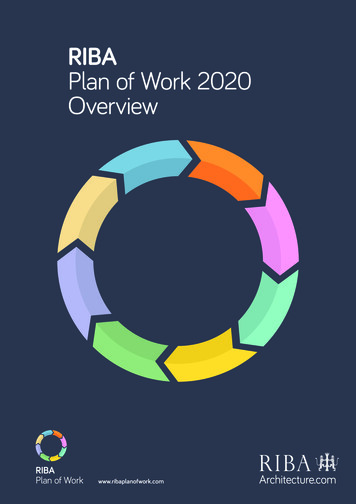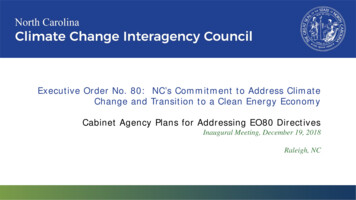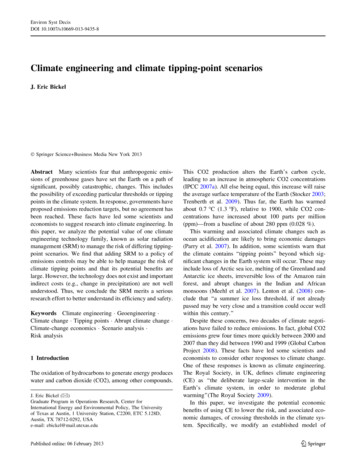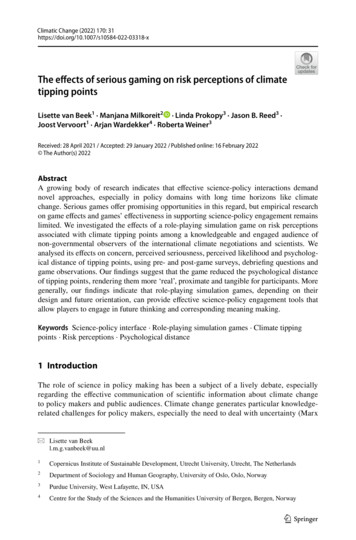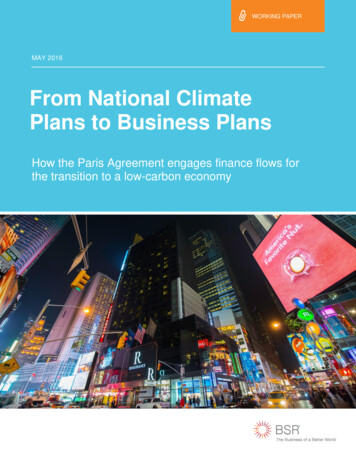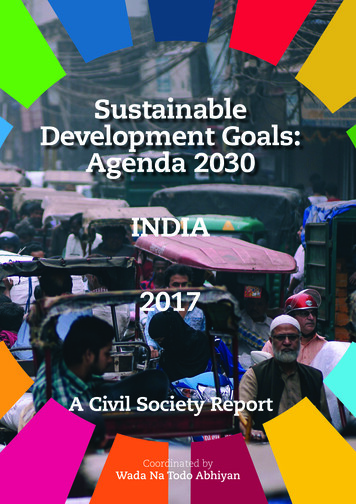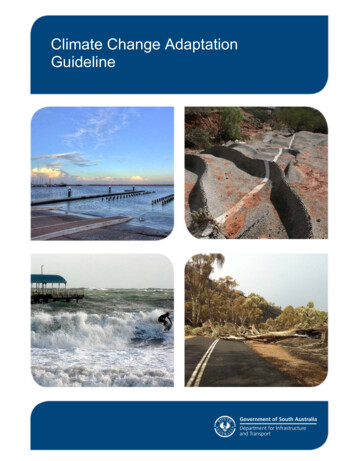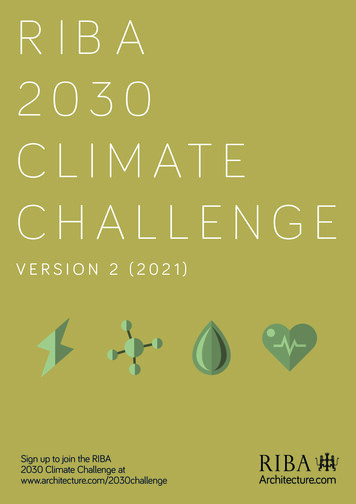
Transcription
R IB A2030C L I M AT ECHALLENGERIBA 2030 Climate Challenge – version 2 (2021)V ERSI O N 2 (202 1)Sign up to join the RIBA2030 Climate Challenge atwww.architecture.com/2030challenge1
RIBA 2030 Climate Challenge – version 2 (2021)2RIBA 2030 Climate ChallengeThe RIBA has developed voluntary performance targets for operational energy use, water use and embodied carbon.1These performance targets form the basis of the 2030 Climate Challenge which the RIBA has been developed inconsultation with other professional UK construction bodies. The performance targets align with the future legislativehorizon and set out a challenging but achievable trajectory to realise the significant reductions necessary by 2030 inorder to have a realistic prospect of achieving net zero carbon for the whole UK building stock by 2050.The RIBA 2030 Climate Challenge does not seek to replace or replicate a building environmental assessment andthere is no associated RIBA 2030 Climate Challenge certification procedure. Instead, the RIBA presents a set ofperformance outcome targets for RIBA Chartered Practices to aim towards. The 2030 Climate Challenge is voluntaryand is based on trust, there is no penalty imposed on Practices or projects that fall short of the Challenge.The purpose of the RIBA 2030 Climate Challenge is to encourage Practices to take action now and tocollaboratively shift in the profession towards outcome orientated design approaches.Joining the RIBA 2030 Climate ChallengeThe 2030 Climate Challenge is currently open to all RIBA Chartered Practices. Signatories who join the Challengecommit to attempt to meet the targets on all their new and major refurbishment projects and commit to submittingdata on these projects2 to the RIBA, when available. Submitted data will be anonymised and used only for specificpurposes as outlined below. Whilst becoming a 2030 Climate Challenge signatory is currently restricted to RIBAChartered Practices, the targets themselves are open source and can be used and embedded into projects or even inbusiness plans.There is no penalty or consequence for projects that miss the Challenge’s voluntary performance targets. Equally byjoining the Challenge, Practices are not mandated to submit data on each and every single project.12Further guidance can be found in the RIBA Sustainable Outcomes Guide (November 2019)The size of ‘new and major’ projects will vary between Practices, depending on Practice size, location etc. The RIBA requests that as a minimum, signatories submitdata relating to their significant projects; ‘significance’ may be reflected in project complexity or cultural value, not necessarily only by project size and cost.
RIBA 2030 Climate Challenge – version 2 (2021)3Take Action NowThe climate emergency demands urgent action and leadership by architects and the wider construction industry.The last decade (2011-2020) was the warmest on record.3 We must act now and play our part in limiting the furtherexacerbation of climate change. In 2019 the UK Government passed a law to require the UK to end its contribution toglobal warming by 2050 by bringing all greenhouse gas emissions to net zero. The built environment sector must doits part to meet this ambition and ensure that new and retrofit buildings deliver net zero whole life carbon in advanceof incoming regulation. The 2019 Green Construction Board Buildings Mission 2030 report4 shows that net zerooperational carbon is already possible. The challenge for the profession is to extend good practice to all future work,as highlighted by the World Green Building Council’s report on net zero embodied carbon.5Net zero whole life carbon should be prioritised in lower density areas using on-site renewables. In urban areasnet zero whole life carbon will likely require additional offsite renewable energy generation, with certified woodlandoffsetting6 in the UK as a last resort. Energy demand reduction and energy efficiency must lead all approachesirrespective of geographical location.Buildings designed today should aim for RIBA 2025 targetsas a minimum and 2030 targets whenever possible.RIBA 2030 Climate Challenge as built target trajectoriesThe RIBA joined the global ‘declare’ movement in June 2019 and to ensure that the strong words of the declaration ofa climate emergency are matched by actions, the RIBA has set RIBA Chartered Practices a challenge of achieving thefollowing reductions as soon as possible but as a minimum for projects in operation in 2030:1. Reduce operational energy demand by at least 60% from current business as usual baseline figures, beforeoffsetting2. Reduce embodied carbon by at least 40% from current business as usual baseline figures, before offsetting3. Reduce potable water use by at least 40% from CIRIA benchmark/ Building Regulation figures4. Achieve all core health and wellbeing metrics (set out in the table below)These reductions will also form the basis of RIBA’s recommendations to Government for future Building Regulationsrequirements.3456State of the Global Climate 2020 (WMO-No. 1264), WMO (2021)Buildings Mission 2030: Background Report to Recommendations from the Green Construction Board in response to the 2030 Buildings Mission (2019)World Green Building Council Advancing Net Zero embodied carbon call to action report (2019)Net Zero Carbon Buildings: A Framework Definition (2019)
RIBA 2030 Climate Challenge – version 2 (2021)4The Targets v2 (2021)The voluntary operational energy and water use and embodied carbon performance targets that are set out in the2030 Climate Challenge have been developed by the RIBA consultation with experts across the industry. The targetstake into account the latest recommendations from the Green Construction Board7 and are aligned with other builtenvironment professional bodies.Originally launched in October 2019, the RIBA 2030 Climate Challenge has now been re-issued as Version 2 (2021)with refined and updated targets that encompass development in the knowledge base of performance trajectories– particularly in the embodied carbon field. The embodied carbon targets in Version 2 are now aligned with LETI,the Whole Life Carbon Network and others, and follow the latest jointly authored guidance. Version 2 of the ClimateChallenge presents ambitious but achievable forward-facing performance outcomes, set against business-as-usualcompliance approaches.As the targets are for performance outcomes of buildings in operation, the RIBA advocates that buildings in designtoday should, as a minimum, adopt the 2025 targets.These targets are based on domestic and commercial buildings, the RIBA recognises that there may need to befurther refinement by sector and building type in the future. In addition, the targets themselves may need furtherrevision in the coming years as more detailed data and further work in sectoral contributions to carbon emissions inline with science-based targets is undertaken by the industry. The RIBA therefore acknowledges the imperfect natureof the targets but give the urgency for action on carbon emissions, there is no time to wait for the perfect set of figuresto be developed.7Buildings Mission 2030: Background Report to Recommendations from the Green Construction Board in response to the 2030 Buildings Mission (2019)
5RIBA 2030 Climate Challenge – version 2 (2021)RIBA 2030 Climate Challenge target metrics for non-domestic (new build offices)RIBA SustainableOutcome MetricsOperational EnergykWh/m2/yBusiness as usual(new build, compliance approach)2025 Targets2030 TargetsNotes130 kWh/m2/yDEC D (90) 75 kWh/m /yDEC B (50) and/orNABERS Base build 5 55 kWh/m /yDEC B (40) and/orNABERS Base build 6Targets based on GIA. Figures includeregulated & unregulated energyconsumption irrespective of source (grid/renewables).221. Use a ‘Fabric First’ approach2. Minimise energy demand. Useefficient services and low carbon heat3. Maximise onsite renewablesEmbodied CarbonkgCO2e/m21400 kgCO2e/m2 970 kgCO2e/m2 750 kgCO2e/m2Use RICS Whole Life Carbon (modulesA1-A5, B1-B5, C1-C4 incl sequestration).Analysis should include minimumof 95% of cost, include substructure,superstructure, finishes, fixed FF&E,building services and associatedrefrigerant leakage.1. Whole Life Carbon Analysis2. Use circular economy strategies3. Minimise offsetting & use as lastresort. Use accredited, verifiableschemes (see checklist).BAU aligned with LETI band E; 2025target aligned with LETI band C and2030 target aligned with LETI band B.Potable Water UseLitres/person/day16 l/p/day(CIRA W11 benchmark) 13 l/p/day 10 l/p/dayCIBSE Guide G.RIBA 2030 Climate Challenge target metrics for non-domestic (new build schools)RIBA SustainableOutcome MetricsBusiness as usual(new build, compliance approach)2025 Targets2030 TargetsNotesOperational EnergykWh/m2/y130 kWh/m /y 70 kWh/m2/y 60 kWh/m2/yTargets based on GIA. Figures includeregulated & unregulated energyconsumption irrespective of source(grid/renewables).2Refer to Department for EducationOutput Specifications for schools:2025: Primary 55 kWh/m2/y,2030: Primary 45 kWh/m2/y1. Use a ‘Fabric First’ approach2. Minimise energy demand. Useefficient services and low carbon heat3. Maximise onsite renewablesEmbodied CarbonkgCO2e/m21000 kgCO2e/m2 675 kgCO2e/m2 540 kgCO2e/m2Use RICS Whole Life Carbon (modulesA1-A5, B1-B5, C1-C4 incl sequestration).Analysis should include minimumof 95% of cost, include substructure,superstructure, finishes, fixed FF&E,building services and associatedrefrigerant leakage.1. Whole Life Carbon Analysis2. Use circular economy strategies3. Minimise offsetting & use as lastresort. Use accredited, verifiableschemes (see checklist).BAU aligned with LETI band E; 2025target aligned with LETI band C and2030 target aligned with LETI band B.Potable Water Usem3/pupil/year4.5 m3/pupil/y 1.5 m3/pupil/y 0.5 m3/pupil/yRefer to Department for EducationOutput Specifications for schools.
6RIBA 2030 Climate Challenge – version 2 (2021)RIBA 2030 Climate Challenge target metrics for domestic / residentialRIBA SustainableOutcome MetricsOperational EnergykWh/m2/yBusiness as usual(new build, compliance approach)2025 Targets2030 TargetsNotes120 kWh/m2/y 60 kWh/m /y 35 kWh/m /yTargets based on GIA. Figures includeregulated & unregulated energyconsumption irrespective of source(grid/renewables).22BAU based on median all electricacross housing typologies in CIBSEbenchmarking tool.1. Use a ‘Fabric First’ approach2. Minimise energy demand. Useefficient services and low carbon heat3. Maximise onsite renewablesEmbodied CarbonkgCO2e/m21200 kgCO2e/m2 800 kgCO2e/m2 625 kgCO2e/m2Use RICS Whole Life Carbon (modulesA1-A5, B1-B5, C1-C4 incl sequestration).Analysis should include minimumof 95% of cost, include substructure,superstructure, finishes, fixed FF&E,building services and associatedrefrigerant leakage.1. Whole Life Carbon Analysis2. Use circular economy strategies3. Minimise offsetting & use as lastresort. Use accredited, verifiableschemes (see checklist).BAU aligned with LETI band E; 2025target aligned with LETI band C and2030 target aligned with LETI band B.Potable Water UseLitres/person/day125 l/p/day(Building RegulationsEngland and Wales) 95 l/p/day 75 l/p/dayCIBSE Guide G.For reference purposes current (2021) Good Practice for new build projects in-use now are as follows:Non-Domestic (new build office):Operational Energy 90 kWh/m2/y (GIA) and/or DEC C(65) and/or NABERS Base build 5; Embodied Carbon LETI Band D 1180 kgCO2e/m2;Potable Water Use 16 l/p/dayNon-Domestic (schools):Operational Energy 75 kWh/m2/y (GIA); Embodied Carbon LETI Band D 870 kgCO2e/m2; Potable Water Use 3m3/pupil/yrDomestic/Residential:Operational Energy 60 kWh/m2/y (GIA) no gas boilers; Embodied Carbon LETI Band D 1000 kgCO2e/m2; Potable Water Use 110 l/p/dayRIBA 2030 Climate Challenge target metrics for all buildingsBest PracticeHealth MetricsReferencesOverheading25-28 C maximum for 1% of occupied hoursCIBSE TM52, CIBSE TM59Daylighting 2% av. daylight factor, 0.4 uniformityCIBSE LG10CO2 levels 900 ppmCIBSE TM40Total VOCs 0.3 mg/m3)Approved Document FFormaldehyde 0.1 mg/m3)BREEAMWith this Challenge, the RIBA seeks to encourage outcome-based approaches to design.The RIBA advocates that buildings designed today should ideally aim for the 2030 targets now, but as a minimumadopt the 2025 performance targets.The RIBA appreciates that some projects may be impeded in delivering these targets by factors outside the CharteredPractices control. Progress above business as usual approaches should therefore be recorded and recognised as anachievement in the right direction along the trajectory towards better performance outcomes.
RIBA 2030 Climate Challenge – version 2 (2021)72030 Climate Challenge Data CollectionSignatories who join the Challenge commit to submit data relating to their significant projects.8 It is the signatories’responsibility to submit the data to the RIBA. The RIBA appreciates that some projects may be impeded in meetingthe Challenge targets for reasons that are outside of the Chartered Practices control. Data should be recorded andsubmitted irrespective of this. Progress towards better performance outcomes above business as usual approaches isrecognised as an achievement in the right direction along the Challenge trajectory.A data form is available for signatories to complete and includes the in-use energy and water performance data ofthe building one year after completion. This information needs to be obtained from the client and should be takenfrom energy/water meter readings (or energy/water bills) for the building over a year, so that both winter and summerseasons feature in the calculation. A Client Guide and Client letter template is available for 2030 Climate Challengesignatories to use to assist in gathering the required client commitment.The RIBA provides assurance that all submitted data will remain anonymous and will only be used by the RIBA to:a) grow industry knowledge of trends in building performanceb) identify trends in building performance gaps between predicted design targets and actual building performance datac) identify opportunities for improvements for sectoral carbon reductionsd) deliver targeted research and knowledge development to the professione) inform future engagement activity for the RIBA membership8‘Significant’ projects will vary between Practices, depending on Practice size and significance may be reflected in project cost or size or complexity/cultural value.
RIBA 2030 Climate Challenge – version 2 (2021)8RIBA 2030 Climate Challenge ChecklistMeeting the RIBA 2030 Climate Challenge targets is essential if architects are to play their part in mitigating climatechange and limiting the rise of global temperature to below 1.5 C.Action from The Government is also critical and the RIBA will campaign for UK Planning and Building Regulations tomeet and/or exceed these targets as soon as possible.The RIBA’s 2030 Climate Challenge Checklist sets out the actions that Chartered Practices will need to take to meetthe Challenge targets.The Challenge focuses on the three environmental sustainability outcomes that all new or refurbished buildingscontribute to: energy use, embodied carbon and water use with an overall aim to target net zero whole life carbonemissions (or better) by 2030 at the latest.Are you ready to take the RIBA 2030 Climate Challenge and commit to attempt to meet the targets and willing tosubmit project data to the RIBA?Sign up at www.architecture.com/2030challenge!Client commitmentSeek Client buy-in for submitting operational energy and water data to the RIBA one year after project completion.RIBA Challenge signatories can access the following tools to assist with engaging clients via the 2030 Challengeportal.Whole life carbonConsider whole life carbon implications of design decisions, and target net zero whole life carbon9 for new andretrofit building projects by 2030. Follow RIBA’s Sustainable Outcomes guide and LETI guidance.10Operational energy and carbon emissionsTarget 55kWh/m2/year operational energy use for non-domestic buildings by 2030 (60% reduction inoperational energy from current business-as-usual baseline figures and maximise the use of on-site renewables.Use low carbon heating, for example heat pumps or connections to non-fossil fuel district heat networks andtarget no new connections to the gas grid for non-domestic building projects by 2025.Target 35kWh/m2/year operational energy use for domestic buildings by 2030 (minimum 50% reduction fromcurrent business-as-usual baseline figures).Design for low carbon heating with no fossil fuel boilers installed in new homes by 2025 at the latest, in line withthe Future Homes Standard and as recommended in the Committee of Climate Change’s ‘UK housing: Fit for thefuture?’11 report.Design using realistic predictions of the operational energy targets to avoid the performance gap and reportthe energy use by fuel type. Disclose the full breakdown of regulated and unregulated energy use. The RIBArecommends the use of rigorous design for performance methods such as CIBSE TM5412 or Better BuildingPartnership Design for Performance.13Use offsetting as last resort, and use a recognised offsetting framework. Offsetting should be follow the 8.Principles as set out in UKGBC’s Renewable Energy Procurement & Carbon Offsetting report (March, 2021).14Net Zero Carbon Buildings: A Framework Definition (2019)RIBA Sustainable Outcomes Guide LETI Net Zero 1 pager and Climate Emergency Design Guide11CCC’s UK housing: Fit for the future? (2019)12CIBSE TM54: Evaluating Operational Energy Performance of Buildings at the Design Stage (2013)13Better Buildings Partnership Design for Performance (2019)14UKGBC’s Renewable Energy Procurement & Carbon Offsetting report (2021)910
RIBA 2030 Climate Challenge – version 2 (2021)Existing building stockAssist existing clients with carrying out post occupancy evaluation and suggest strategies for fine-tuning existingbuildings to reduce energy use and operational carbon emissions.15Prioritise the retention, reuse and repurposing of existing buildings where possible and where retrofit upgradesmake carbon sense from a whole life perspective.Embodied energy and carbon emissionsPrioritise the refurbishment and retrofit of existing buildings where possible.Target an embodied carbon performance of 750 kgCO2e/m2 for non-domestic office buildings and 625 kgCO2e/m2 for domestic buildings by 2030 (minimum 40% reduction in embodied carboncompared to the current business as usual benchmarks) by using low carbon materials that are responsiblyand ethically sourced.Evaluate embodied carbon using the RICS Whole Life Carbon Assessment for the Built Environmentprofessional statement 201716 methodology and approach and include modules A1-5, B1-5, C1-4 (includingsequestration), including a minimum of 95% of the cost allocated to each building element category (0-7 ofTable 3, page 11 of RICS Whole Life Carbon Assessment).Embodied carbon assessments should reflect all items listed in the project’s Bill of Quantities, since RIBAChallenge are out as-built performance targets.Reasonable assumptions need to be made in terms of level of detail of the project, in line with EN 15978.Any Whole Life Carbon Assessment report should clearly state which RIBA stage it was undertaken in andshould therefore reflect the appropriate level of detail.On projects where Whole Life Carbon assessments are not being undertaken as part of the project team’score services, effort should be focussed on reducing embodied carbon following the hierarchy in LETI designguidance,17 and reasonable endeavours should be made to quantify the embodied carbon savings achieved.Analysis tools such as H\B:ERT or FCBS CARBON may be used assist the process.18Offset remaining carbon emissions either through renewable energy projects and/or certified woodlandafforestation or peatland projects, using a recognised offsetting framework. Offsetting should be follow the 8.Principles as set out in UKGBC’s Renewable Energy Procurement & Carbon Offsetting report (March, 2021).19Water useTarget 10 litres/person/day for non-domestic buildings and 75 litres/person/day for domestic buildings(minimum 40% reduction in potable water use compared to CIRIA guidance20 and UK Building Regulationsrequirements21), by minimising water demand, optimising building systems, and harvesting rainwater as well asrecycling and reusing water on-site.Indoor healthAvoid unintended consequences of poor health and wellbeing by meeting key health and wellbeing metrics setout in the RIBA 2030 Climate Challenge.RIBA Plan for Use Guide (March 2021)RICS Whole Life Carbon Assessment for the Built Environment Professional Statement (2017). Design tools exist that embody the RICS embodied carboncategories to help ensure consistency and equivalence of measurement. See also: RIBA Embodied and Whole Life Carbon Assessment for Architects (2017).17LETI Embodied Carbon one-pager18H\B:ERT or FCBS CARBON19Offset schemes must follow a recognised scheme e.g. CDM (Clean Development Mechanism), Verra’s Verified Carbon Standard (VCS) scheme or the GoldStandard. In the UK afforestation and peatland projects should be certified either through the UK Woodland Carbon Code or the UK Peatland Code20CIRA W11: Key Performance Indicators for water use in offices21Building Regulation 36, guidance can be found in Approved Document Part G.15169
RIBA 2030 Climate Challenge – version 2 (2021)10BiodiversitySignificantly enhance the project site’s biodiversity net gain and green cover compared to pre-development levels.22Plan for ongoing maintenance and management of green/blue infrastructure on site, to ensure biodiversity netgain is remains a continued legacy.DeliveryFollow the RIBA Plan of Work Sustainability Strategy23 and RIBA Plan for Use Guide24 and undertake at least lighttouch post occupancy evaluation25 to gather predicted and actual performance of existing and new building projects.Submit energy, water and embodied carbon data to the RIBA For further guidance on additional sustainabilitymetrics see the RIBA Sustainable Outcomes Guide.5Data SubmissionSubmit energy, water and embodied carbon project performance data to the RIBA.Compile and collate data using the RIBA 2030 Challenge data submission form. Data required includes the inuse energy and water performance data of the building one year after completion. This information needs to beobtained from the client and should be taken from energy/water meter readings (or energy/water bills) for thebuilding over a year, so that both winter and summer seasons feature in the calculation.It is the 2030 Challenge signatories’ responsibility to submit the data to the RIBA.Data ProtectionThe RIBA provides assurance that all submitted data will remain anonymous and will only be used by the RIBA inaccordance with the principles set out above in this document.Biodiversity Net Gain approachRIBA Plan of Work 202024RIBA Plan for Use Guide (March 2021). Members may wish to use formal BSRIA Soft Landings processes25In addition to the RIBA Plan for Use Guide see Housing Fit for Purpose, Performance, Feedback and Learning, Fionn Stevenson (2019) for domestic postoccupancy evaluation2223
Royal Institute of British Architects 2021Royal Institute of British Architects66 Portland Place, London W1B 1ADTel: 44 (0)20 7580 5533 Email: info@riba.org
of incoming regulation. The 2019 Green Construction Board Buildings Mission 2030 report4 shows that net zero operational carbon is already possible. The challenge for the profession is to extend good practice to all future work, as highlighted by the World Green Building Council's report on net zero embodied carbon.5
